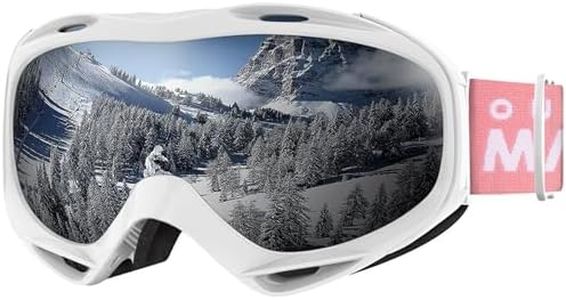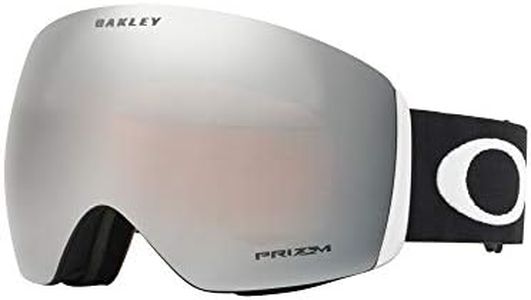We Use CookiesWe use cookies to enhance the security, performance,
functionality and for analytical and promotional activities. By continuing to browse this site you
are agreeing to our privacy policy
10 Best Ski Goggles
From leading brands and best sellers available on the web.By clicking on a link to a third party's website, log data is shared with that third party.
Buying Guide for the Best Ski Goggles
When choosing ski goggles, it's important to remember that they do more than just look cool—they protect your eyes from harsh sunlight, wind, cold, and snow while also enhancing your vision on the slopes. Picking the right pair can improve your comfort, safety, and experience whether you're skiing for the first time or are a seasoned pro. Focus on features that match the kind of weather and light conditions you expect, as well as your fit and comfort.Lens TypeThe lens is the heart of the goggles. Ski goggle lenses come in various types: cylindrical (flat), spherical (curved), or toric shapes. Cylindrical lenses are flatter and generally more affordable, but can create more glare and minor distortion. Spherical lenses curve both side-to-side and up-and-down, offering better peripheral vision, reduced glare, and less distortion, which is great for those who want the best visuals on the slopes. Toric lenses combine aspects of both for a balance of vision and fit. For most casual users, cylindrical lenses do the job, but if ultimate visual clarity and less distortion matter to you, consider spherical or toric.
Lens Tint/ColorLens tint refers to the color and darkness of the lenses. Lighter tints (like yellow, gold, or rose) are ideal for cloudy or low-light conditions because they brighten your view, while darker or mirrored tints (like black, grey, or bronze) reduce glare and are best for bright, sunny days. There are also all-around tints that work for mixed conditions. Think about when and where you'll typically ski—if you’re mostly out in sunshine, go for darker tints; if you love cloudy or night skiing, pick lighter tints.
VLT (Visible Light Transmission)VLT is a percentage showing how much light passes through the lens. Low VLT (5–20%) means less light passes through, which is perfect for sunny days as it blocks out more brightness. High VLT (60% and above) is best for overcast or night, as it lets in more light. Medium VLT (20–60%) is for partly cloudy conditions. Match your VLT to your typical skiing weather to avoid squinting or struggling to see.
Fit and ComfortA good fit ensures your goggles stay put and don’t cause discomfort or gaps that can let in wind and snow. Goggles come in various sizes, usually labeled as small, medium, or large, and some are designed to fit over glasses (OTG). Try them on with your helmet if possible, and check the foam cushioning and adjustable strap to see how they feel. Go for the size and style that sits comfortably on your face and works with your helmet.
Ventilation and Anti-Fog FeaturesVentilation helps prevent your goggles from fogging up by letting air circulate inside. Most ski goggles have vents along the top, bottom, or sides. Some also have anti-fog coatings on the lens. If you tend to overheat, ski hard, or experience fogging, look for goggles with good airflow and anti-fog technologies. This will help keep your vision clear on the slopes.
Interchangeable LensesSome goggles allow you to quickly change lenses to match different weather conditions. This is great if you ski in a variety of light situations; you can swap in a low-light lens on cloudy days and a dark lens when it’s bright. If you prefer convenience and flexibility, choose goggles with an easy lens-changing system.














